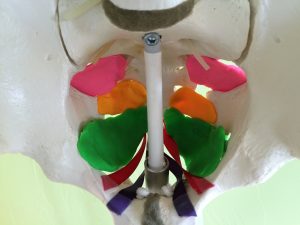
Personal trainers would benefit from knowing the value of Kegel exercises for their clients. Kegels are an exercise that strengthens the pelvic floor muscles. Pelvic floor muscles ideally work in harmony with the hips and abdominals as part of the larger movement system, making them a crucial component of strength training.
Pelvic floor muscles are just as important as biceps, abs, and glutes. Maybe even more so because they support the structure for all of these other muscles along with several important organs – including the bladder.
Why are Kegels important for both men and women?
Anyone, male or female who is wanting a stronger core and incontinence prevention or treatment should be doing Kegels. A strong pelvic floor supports the bladder to prevent and address urination issues. Pelvic floor strength is crucial for daily activities of living, especially when working with special populations such as prenatal, postpartum, senior citizens, and prostate cancer patients and survivors.
The pelvic floor holds a second set of organs (baby!) during pregnancy and usually needs retraining and strengthening postpartum. Cancer treatments performed in the pelvic region can cause muscle weakness. Carol Michaels, the creator of the Cancer Exercise Specialist Program says, “Kegels are great for prostate cancer patients because they minimize incontinence and can improve erectile issues. They can help control incontinence without medication or surgery. It is wise to start Kegel exercises before surgery and treatments.”
Kegels are ideally trained in a variety of positions (laying down, sitting, standing), but can be worked anywhere, anytime in any position – no gym necessary! So, teach them to your clients and help them identify when a good time is for them to work those pelvic floor muscles – such as when sitting in a meeting, waiting at a traffic light, or reading books to children.
What is a Kegel exercise and how is it done?
Most often a Kegel exercise is described as the contraction of muscles that stop the flow of urine. Performing a Kegel is more complex than this though because it involves a “drawing in and up” sensation. Have your client imagine grasping his hands around a ball of Play-Doh to squeeze it. This is the main feeling you want him to experience when performing a kegel.
Many people perform Kegels incorrectly by pushing down and out onto the pelvic floor with other surrounding muscles. Carrie Myers, a therapeutic exercise physiologist coaches her clients to picture an elevator coming up into the abdomen from the pelvic floor and cues “level one, level two, level three”.
Drawing up and in is what pelvic muscles need to be trained to do to support the abdominal cavity. Pushing down and out overrides the pelvic floor muscles and usually indicates usage of other larger, stronger muscles such as the abdominals.
How long should you perform Kegels and how many each day?
Have your client start by doing one Kegel properly and holding it for as long as she can, ideally 5-10 seconds, three times per day. Have her work up to 5-10 repetitions three times per day. Suggest contractions that are short and repeated as well as contractions that are held isometrically so to work both fast and slow twitch muscle fibers.
When re-training a weak pelvic floor your client may tire more easily in the beginning and need to do them more frequently throughout the day. Eventually, pelvic floor muscles should be trained at the same frequency as other muscles so not to over-work them, but to maintain strength. Kegels are a great warm-up movement for abdominal work. As with any exercise, Kegels become easier and more natural as strength is gained.
Tips for Kegel Exercises
- Relax the surrounding muscle groups in the buttocks, legs, and abdomen.
- Visualize lifting the pelvic floor upward rather than pushing down and out (like when eliminating).
- Relax the pelvic floor muscles completely in between contractions by inhaling and exhaling slowly so the muscles can fully contract and relax – avoiding hypertonicity.
- Use the above image of the pelvic floor to visualize the muscles that are contracting.
- Don’t do Kegels when urinating, except when first learning to locate the muscles and build awareness.
Kegel exercises should be part of a well-rounded fitness program. They are just as important as pull-ups, push-ups, and planks. Even though Kegels are especially important for special populations everyone should be doing them (including fitness instructors) so introduce the Kegel to your clients in your next workout during the warm-up. It will support and benefit all the other exercises they do.



